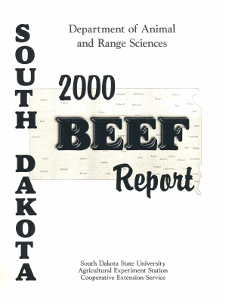Document Type
Report
Report Number
2000-10
Publication Date
2000
Summary
Yearling steers (n = 400) were used to evaluate relative payout periods for implants when feeding high grain content diets. Implant treatments included (1) control (nonimplanted), (2) Synovex Plus, (3) revalor-S, and (4) Ralgrorevalor-S. The Synovex Plus (2), revalor-S (3) and Ralgro (4) were administered on day 1. The reimplant with revalor-s (4) was administered after 56 d on feed. Steers were managed in two groups. Initial BW and days fed were 782 Ib, 131 d (Group I), and 661 Ib, 145 d (Group 11). Implants increased production rates and efficiencies, increased carcass size and reduced marbling when compared to nonimplanted controls. Production rates and efficiencies and carcass sizes were similar among steers that received implants. Marbling scores and percentage choice carcasses were affected by implants. In general, the delayed use of an estradiol-trenbolone acetate implant improved marbling over d 1 implanting even though there were 56 fewer days on feed after implanting. The energy density of live weight gain was calculated over the course of the feeding period based upon interim period BW and DM1 determinations. Higher energy content of gain early in the feeding period for treatments 1 and 4 were related to marbling, while the energy content of gain late in feeding period was not. These data showed no differences in the relative effective duration of Synovex Plus and revalor-S implants. The influence of implants on carcass quality grades was affected by factors other than elapsed time from implanting to harvest.
Number of Pages
9
Format
application/pdf
Language
en
Publisher
South Dakota State University
Rights
Copyright © 2000 South Dakota State University
Recommended Citation
Pritchard, Robbi H., "Comparison of Estradiol-Trenbolone Acetate Implant Programs for Yearling Steers of Two Genotypes" (2000). South Dakota Beef Report, 2000. 11.
https://openprairie.sdstate.edu/sd_beefreport_2000/11

